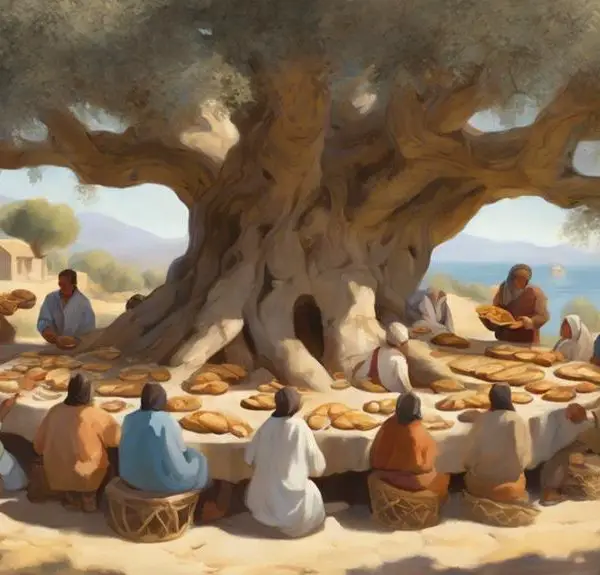From social status to divine provision, discover the multifaceted symbolism of raiment in the Bible and its impact on faith.

What Does Raiment Mean in the Bible
In the vast expanse of the Bible, you could journey for miles without ever fully grasping the profound significance of a single word: raiment. It's not just ancient clothing; it's a multifaceted symbol that weaves through texts, revealing social status, spiritual conditions, and divine care.
As you explore, you'll discover how raiment distinguishes prophets from kings, the rich from the poor, and the righteous from the sinners. But the thread doesn't stop there. The symbolic layers wrapped in this term are as intricate as the finest tapestry, inviting you to uncover how divine provision and spiritual truths are elegantly dressed in the biblical narrative.
Why does this matter, you ask? Well, the answer might just change how you view the fabric of your own faith journey.
Key Takeaways
- Raiment symbolizes spiritual righteousness, covering, and the divine provision and protection by God.
- The state and style of raiment can reflect one's social status, spiritual purity, and humility.
- In biblical narratives, colors and materials of raiment carry deep spiritual meanings, such as purity, royalty, and penitence.
- Clothing imagery in the Bible teaches profound spiritual truths about internal character, divine acceptance, and the importance of spiritual integrity.
Defining 'Raiment' Biblically

In biblical texts, 'raiment' refers to garments or clothing, a term that encapsulates the diverse attire worn by people across different eras and regions within the scriptures. The concept of raiment is integral to understanding the cultural and historical contexts of biblical narratives. You'll find that cultural variations significantly influence the types of raiment depicted.
For example, the ancient Israelites' attire differed markedly from that of the Egyptians, as seen in the contrasting descriptions of Joseph's coat of many colors versus the fine linen worn by Egyptian royalty. This distinction underscores the importance of recognizing how cultural identities are woven into the fabric of biblical stories.
Moreover, fabric choices play a crucial role in delineating different types of raiment. Linen, wool, and skins are among the materials mentioned, each chosen for its specific qualities and symbolic meanings. Linen, often associated with purity and priestly garments, contrasts with the more commonplace wool.
The selection of fabric not only reflects the available resources but also conveys deeper symbolic and religious significance, illustrating the multifaceted role of raiment in the biblical world.
Raiment as Social Indicator
Within biblical narratives, raiment often serves as a potent indicator of an individual's social status, highlighting distinctions between the wealthy and the impoverished, the powerful and the powerless. This differentiation isn't merely superficial; it's deeply embedded in the fabric of societal norms and clothing customs of ancient times. The garments one wore could instantly convey one's economic standing and societal role, serving as a visual shorthand for one's place in the social hierarchy.
- Materials and Quality: The wealthy adorned themselves with garments made from fine linen and silk, a direct contrast to the coarse materials worn by the less fortunate.
- Color and Design: Rich, vibrant colors and intricate designs were reserved for the elite, symbolizing affluence and authority.
- Accessories and Embellishments: Precious metals and gems adorned the raiment of the affluent, further accentuating economic disparity.
- Maintenance and Presentation: The condition and cleanliness of clothing also mirrored social status, with the well-off able to maintain and present their garments impeccably.
In dissecting these clothing customs, one gains insight into the profound economic disparities that characterized ancient societies. The raiment worn wasn't just about fashion or preference; it was a reflection of one's standing, aspirations, and societal constraints.
Spiritual Symbolism of Raiment

Raiment transcends mere clothing in biblical contexts, often embodying profound spiritual symbolism that reflects one's faith and divine favor. Analyzing the scriptures, you'll find that both color significance and material importance are pivotal to understanding the deeper spiritual messages conveyed through raiment.
Colors like white, purple, and scarlet don't just serve aesthetic purposes; they communicate purity, royalty, and sacrifice, respectively. Similarly, materials such as linen, wool, and sackcloth are not chosen arbitrarily. Linen, often associated with the priesthood and purity, and wool, signifying wealth and status, contrast sharply with sackcloth, a symbol of mourning and penitence.
Color/Material |
Symbolic Meaning |
Biblical Reference |
|---|---|---|
White |
Purity, Righteousness |
Revelation 19:8 |
Purple |
Royalty, Authority |
Judges 8:26 |
Scarlet |
Sacrifice, Sin |
Isaiah 1:18 |
Linen |
Purity, Priesthood |
Exodus 28:42 |
This table highlights the intricate interplay between the physical and spiritual realms in biblical narratives. The choice of raiment in these texts is never incidental but is imbued with rich layers of meaning, pointing towards broader theological themes such as redemption, sanctification, and divine hierarchy. Understanding these symbols allows you to grasp the depth of biblical teachings on a more profound level.
Divine Provision and Raiment
Exploring the biblical narrative further reveals how divine provision is often symbolized through the provision of raiment, underscoring a deeper connection between spiritual blessings and physical attire. The Bible is replete with instances where clothing isn't just a matter of practical necessity but a manifestation of God's providential care and grace. These clothing miracles serve not only as a testament to God's attentiveness to our needs but also as a symbolic gesture of His provision for our spiritual well-being.
Consider these examples that illustrate the divine provision through raiment:
- The garments of skin for Adam and Eve: After their fall, God made garments of skin for Adam and Eve, covering their nakedness and shame, symbolizing His mercy and provision.
- Joseph's coat of many colors: This gift from Jacob to Joseph wasn't only a sign of favor but also foreshadowed God's providential care over Joseph's life, leading him from slavery to governance in Egypt.
- Elijah's mantle: Elijah passing his mantle to Elisha symbolized the transfer of prophetic authority but also God's provision of spiritual leadership for His people.
- Jesus' seamless garment: At the crucifixion, Jesus' seamless garment symbolized His perfection and the seamless nature of His teachings, underscoring God's ultimate provision of salvation through Christ.
These narratives highlight how providential care is intricately woven with the provision of clothing, demonstrating God's comprehensive care for His people, both physically and spiritually.
Raiment in Parables and Teachings

The parables and teachings of the Bible frequently employ clothing imagery to convey profound spiritual truths, emphasizing the significance of internal character over external appearances. This use of raiment as a metaphor provides a rich layer of meaning, often incorporating color significance and garment preservation to deepen the messages being communicated. For instance, the wearing of white garments typically symbolizes purity and righteousness, serving as a visual metaphor for spiritual cleanliness and divine acceptance. This color significance isn't merely decorative; it's a deliberate choice to reinforce the moral and ethical teachings of the scripture.
Furthermore, the emphasis on garment preservation in these narratives highlights the importance of maintaining one's spiritual integrity in the face of corruption and decay. Just as a garment must be cared for to prevent wear and tear, so too must one's soul be nurtured and protected. This analogy encourages you to reflect on the durability of your spiritual commitments, urging you to consider how you're preserving your moral and ethical values in a world fraught with challenges.
Through these teachings, you're invited to look beyond the superficial and focus on the essence of your spiritual being, using the symbolism of raiment as a guide for personal growth and reflection.
Frequently Asked Questions
How Has the Translation and Interpretation of "Raiment" Evolved in Modern Bible Translations Compared to Ancient Texts?
In exploring how 'raiment' has transformed in Bible translations, you'll find translation challenges and cultural context at the core. Modern versions often shift towards contemporary language, aiming for clarity and relevance.
This evolution reflects a deep dive into ancient texts, ensuring that interpretations honor original meanings while making them accessible today. Analyzing these changes reveals the delicate balance between staying true to ancient scripts and connecting with current readers' understanding and sensibilities.
Are There Any Notable Differences in the Significance or Use of Raiment Between the Old Testament and the New Testament?
You're treading through a tapestry of time, where raiment symbolism weaves its narrative.
In the Old Testament, raiment often mirrors status and divine favor, a metaphor for blessings and identity.
Transition to the New Testament, and you'll notice a shift. Here, raiment metaphors evolve to underscore humility and spiritual richness, diverging from earthly wealth.
This nuanced difference highlights how spiritual narratives adapt raiment's significance, reflecting each era's theological undercurrents.
How Do Non-Christian Religious Texts and Traditions Interpret or Value the Concept of Raiment, Especially in a Spiritual or Symbolic Context?
In exploring non-Christian texts, you'll find that Islamic modesty and Hindu dharma imbue raiment with deep spiritual and symbolic significance.
Islam emphasizes modesty, viewing clothing as a means to protect purity and express faith. Similarly, Hinduism interprets raiment through the lens of dharma, where attire reflects one's societal role and spiritual journey.
Both traditions highlight how garments serve not just practical needs but also convey profound ethical and spiritual values.
In What Ways Have Contemporary Christian Denominations Diverged in Their Understanding or Emphasis on the Symbolism of Raiment?
You'll find that contemporary Christian denominations show a wide range of approaches to clerical vestments and worship attire, reflecting their varied interpretations of spiritual symbolism.
Some prioritize traditional garb as a sign of reverence and continuity, while others lean towards casual attire, emphasizing accessibility and community.
This divergence underscores the evolving nature of religious expression, where attire serves not just a functional role but also a deeply symbolic one in worship practices.
Can the Concept of Raiment in the Bible Provide Insights Into the Historical Fashion Trends and Textile Technologies of Ancient Cultures Mentioned in the Scripture?
Absolutely, the concept of raiment in the scriptures can shed light on ancient cultures' fashion trends and textile technologies. Through meticulous examination of textile preservation and color symbolism within these narratives, you'll uncover how clothing choices reflected societal values, status, and technological advancements.
This analytical dive into biblical references offers a fascinating glimpse into the past, revealing the rich tapestry of historical dress practices and materials.
Conclusion
In your journey through biblical texts, you've discovered that 'raiment' isn't merely clothing; it's a tapestry of cultural, spiritual, and divine narratives. Juxtaposed against the backdrop of ancient society, raiment tells a tale of identity and providence.
It's both a mundane necessity and a profound symbol, woven into parables and teachings. This exploration reveals how scripture uses the tangible to elucidate the intangible, inviting you to ponder the layers of meaning behind the material.



Sign up